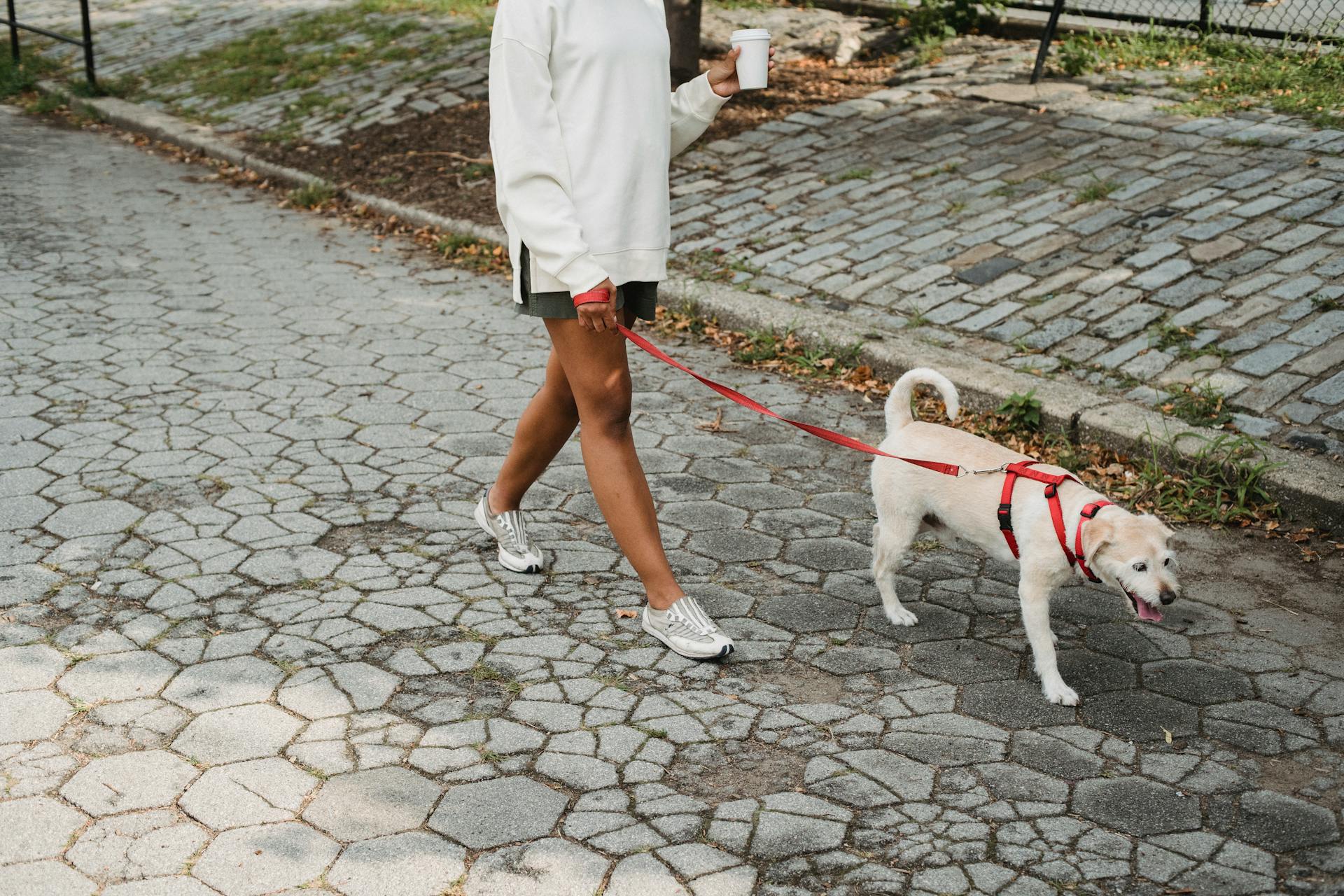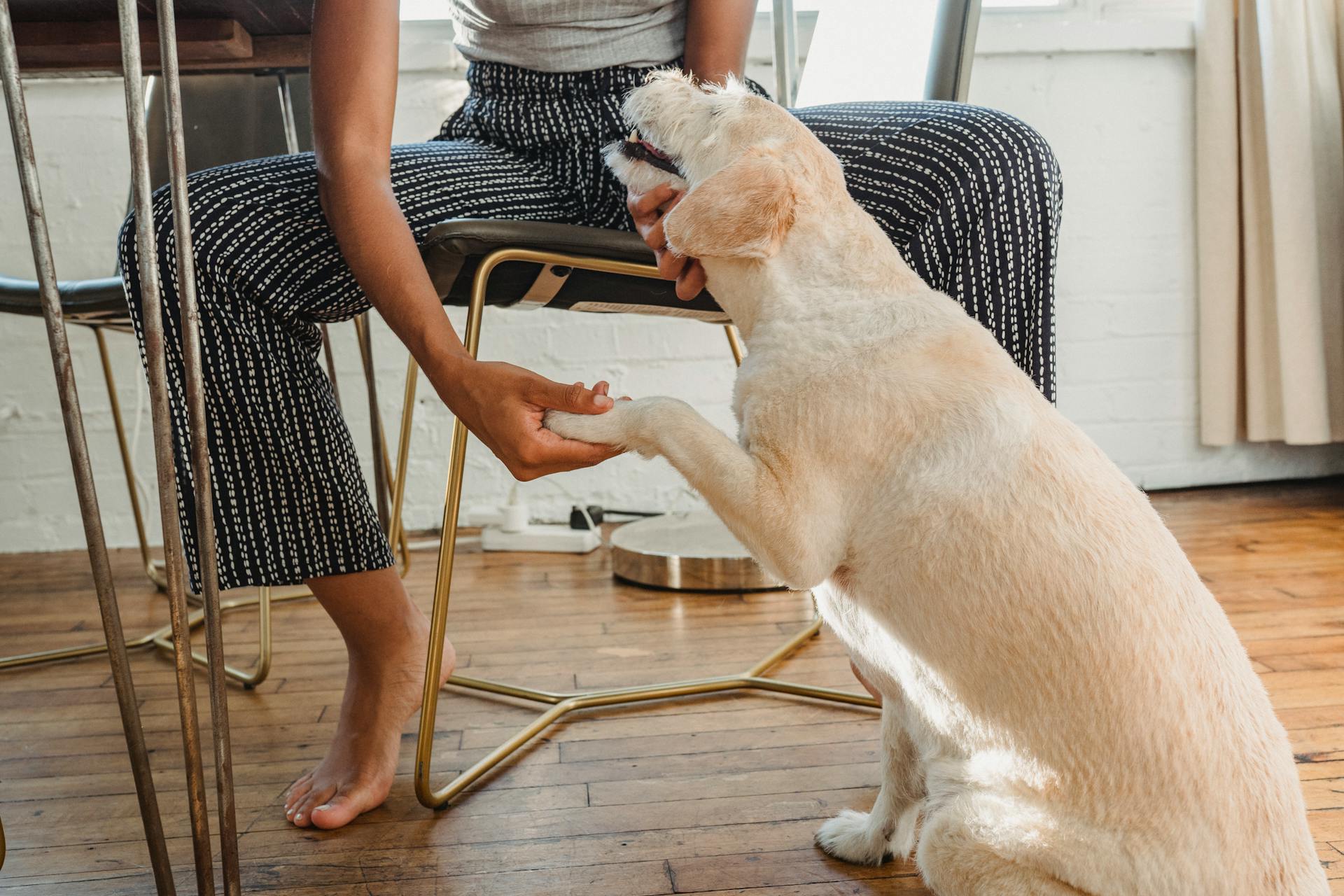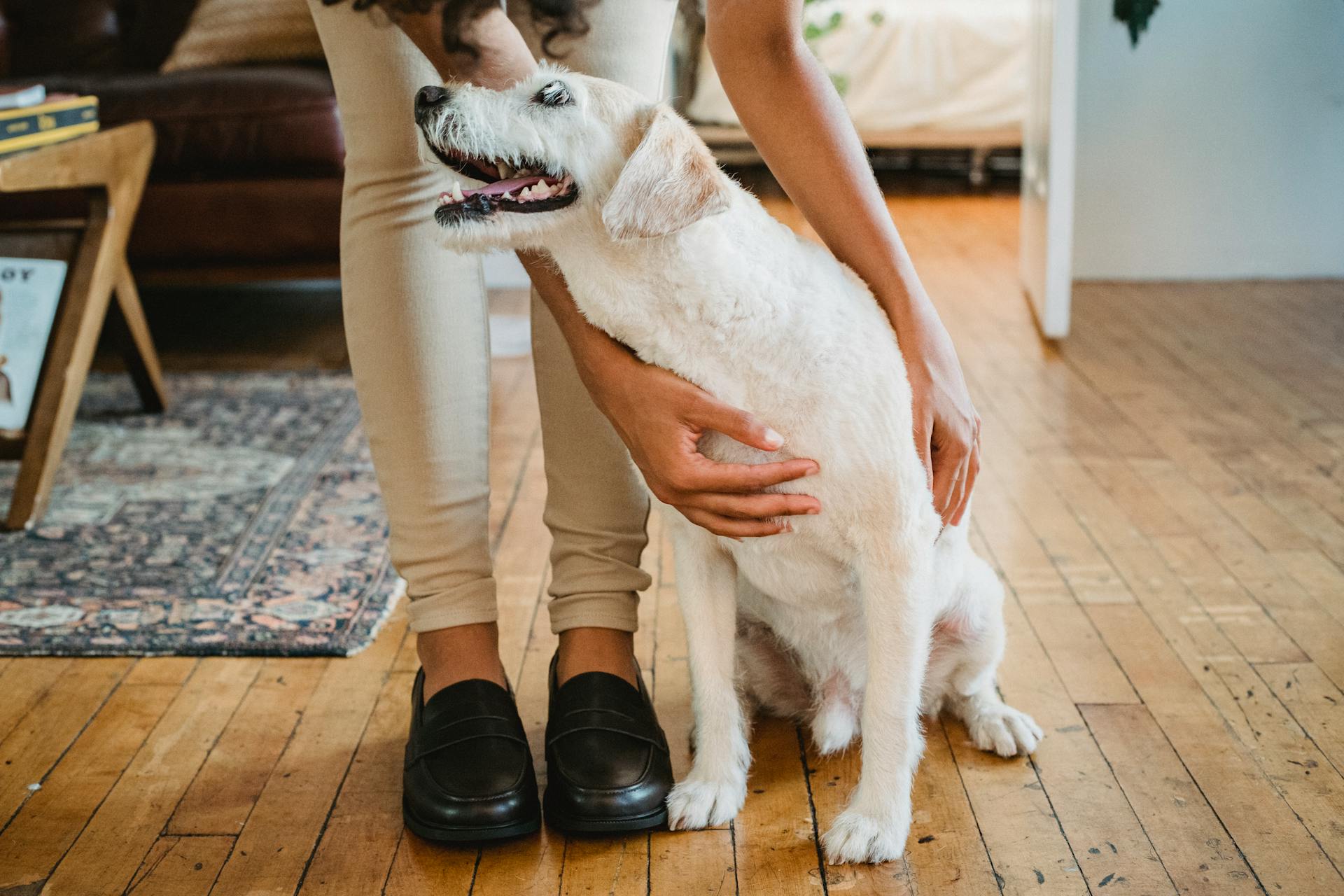
A female dog hernia can be a painful and potentially life-threatening condition if left untreated.
The most common symptom of a female dog hernia is a visible bulge or swelling in the groin area.
In some cases, the hernia may not be visible, and the only indication of a problem is a change in your dog's behavior, such as whining or restlessness.
A female dog hernia can be caused by a variety of factors, including genetics, obesity, and injury.
What Is a Hernia?
A hernia is a condition where there is a weakness in the abdominal wall, allowing internal contents to protrude through the opening. This can happen anywhere along the abdominal wall, but it's most common near the belly button.
The opening can be small or large, and it can cause a soft bulge or swelling under the skin. This bulge can be painful or non-painful, depending on what's inside it.
A hernia can involve various tissues, including intestines or fat, which can pass through the opening and become trapped. If the intestine twists and becomes trapped, it can cause a lot of pain and swelling.
Complicated hernias involve abdominal contents, such as a portion of the intestine, which can become trapped and swollen.
Discover more: Can a Bug Bite Cause a Lump on a Dog
Causes and Symptoms
Umbilical hernias in female dogs can be caused by incomplete closure of the umbilical ring, which leaves a weakening in the abdominal wall. This can lead to tissue herniating out.
Increased abdominal pressure can also cause a hernia to develop, especially if a dog is constantly straining due to activities like coughing, straining to defecate, or vomiting diarrhea. Pregnancy can also put pressure on the abdominal wall.
Certain breeds of dogs, such as Airedale Terriers and Maltese, are genetically predisposed to umbilical hernias. Genetics can play a role in determining whether a dog is likely to have an umbilical hernia, as they tend to appear in family lines.
Some common symptoms of dog hernias include vomiting, loss of appetite, cramping, high fever, leg numbness, lethargy, swelling, shortness of breath, and excessive drooling.
Here's an interesting read: Reverse Sneezing and Vomiting in Dogs
Symptoms
A dog with a hernia may experience a range of symptoms, depending on the type and location of the hernia.

Swelling around the anus is a common sign of a perineal hernia, which can be accompanied by constipation, straining or inability to defecate and urinate, and urinary incontinence.
Some dogs may also experience abdominal pain, loss of appetite, lethargy, and depression due to the discomfort.
A soft bulge over the navel area is a common sign of an umbilical hernia, which is typically reducible and usually small in size.
The bulge may become larger when the dog barks, coughs, or strains, and is often painless.
Here are some common symptoms of dog hernias:
- Vomiting
- Loss of appetite
- Cramping
- High fever
- Leg numbness
- Lethargy
- Swelling
- Shortness of breath
- Excessive drooling
In severe cases, a strangulated hernia can occur, which is a medical emergency that requires immediate veterinary attention.
Causes of Canine Illnesses in Dogs
Umbilical hernias in dogs can be caused by a few different factors. One of the main causes is an incomplete closure of the umbilical ring, which can leave a weakening in the abdominal wall and allow tissue to herniate out.
Increased abdominal pressure can also contribute to the development of an umbilical hernia. This can be caused by activities such as straining to defecate, vomiting, diarrhea, or pregnancy.
Traumatic injury to the abdomen can also cause a hernia to develop. This can occur if a dog sustains a high-impact blow to the abdominal area.
Certain breeds of dogs are genetically predisposed to umbilical hernias. These breeds include Airedale Terriers, Maltese, Pekinese terriers, Basenjis, Poodles, and Yorkshire terriers.
Family lines can also play a role in the development of umbilical hernias. This suggests that genetics may contribute to the likelihood of a dog developing an umbilical hernia.
Here are some breeds that are prone to umbilical hernias:
- Airedale Terriers
- Maltese
- Pekinese terriers
- Basenjis
- Poodles
- Yorkshire terriers
Diagnosis and Treatment
Diagnosis of a hernia in your female dog is usually straightforward, with the swelling being visible on physical exam and located just below the ribcage, near the belly button area.
Your vet may need to use further diagnostics like X-rays or abdominal ultrasound scans to determine what's involved inside the hernia. This will help them understand the extent of the hernia and make an accurate diagnosis.
If your dog's hernia is not visible, your vet may need to do X-rays to find out where the hernia is, and an abdominal ultrasound may be required to find out what contents are trapped. Your vet will also be on the lookout for any respiratory, abdominal disorders, and any painful or hard bulges.
A simple surgery is usually required to correct the hole and replace the abdominal contents back into the abdomen. If your dog is not already spayed or neutered, this treatment will be highly recommended as it can prevent hernias in dogs.
A unique perspective: Does Getting a Female Dog Fixed Calm Her down
Hernia Diagnosis
A diagnosis of an umbilical hernia in dogs is usually straightforward, with the swelling visible on physical exam, specifically located just below the dog's ribcage.
The location of the hernia is key to diagnosis, as it will only be present over the belly button area.
Your vet may feel the hernia during an exam if it's not easily visible, or they may need to do X-rays to determine where the hernia is.
Suggestion: Dog Names Female Start with S

An abdominal ultrasound may also be required to find out what contents are trapped inside the hernia.
Your vet will also be on the lookout for any respiratory, abdominal disorders, and any painful or hard bulges during the exam.
If your dog's hernia is not easy to see, your vet may have to do X-rays to find out where the hernia is.
Treatment for Dogs
A dog with a hernia needs medical treatment as soon as possible because they can't outgrow it and it won't heal on its own.
If your dog is not already spayed or neutered, it's highly recommended to do so after treatment to prevent future hernias.
A simple surgery is usually required to correct the hole and replace the abdominal contents back into the abdomen.
Some hernias will spontaneously close on their own, usually by 6 months of age, but this is not always the case.
In mild cases, a hernia can be left and monitored until the dog is due to be neutered, but larger hernias should always be repaired to prevent serious complications.
Curious to learn more? Check out: Treatment for Female Dog Incontinence
Surgical correction involves checking over any abdominal contents that have moved out of the body, replacing them, and using a strong suture material to pull the edges of the umbilical ring together.
If there is a very large hole, a mesh may be used to prevent abdominal organs from moving outside the body wall.
In female dogs, the incision for the spay just needs to be extended slightly to incorporate the hernia, while in male dogs, a separate incision will need to be made.
A different take: My Dog Has a Terrible Odor
Prevention and Care
Preventing umbilical hernias in dogs is not directly possible, but you can reduce the risk by being aware of breeds that are genetically predisposed to hernias. This knowledge can help you make informed decisions when choosing a breeder.
Maintaining a healthy weight for your dog is crucial in reducing strain on the abdominal wall, which can help prevent hernias from occurring. Regular vet visits and health checks can also ensure your dog stays fit and healthy.
If you do suspect your dog has a small hernia, monitoring it may be a viable option, as some hernias can resolve on their own by 6 months of age. However, larger hernias should always be repaired to avoid serious complications.
Prevention Possibility

Unfortunately, it's not possible to directly prevent umbilical hernias in dogs, but there are ways to reduce the risk of them occurring.
Any reputable breeder will not use a dog for breeding if they have a large umbilical hernia, and they won't use two dogs that have small umbilical hernias.
Good owner education is important so that people are aware of which breeds are genetically predisposed and therefore more likely to have hernias.
Some breeds that are genetically predisposed to umbilical hernias include Airedale Terriers, Maltese, and Pekinese Terriers, Basenjis, Poodles, and Yorkshire Terriers.
Maintaining a healthy weight can help reduce strain on the abdominal wall, which can contribute to hernias.
Regular vet visits and health checks can help ensure your dog is as fit as possible.
Here are some ways to reduce the risk of umbilical hernias:
- Keep your dog at a healthy weight
- Regular vet visits and health checks
- Choose a reputable breeder who prioritizes genetic health
Caring for a Dog with a Hernia
Dogs with small umbilical hernias can lead a normal life, but it's essential to monitor the hernia closely and have regular vet visits to assess its severity.
Mild cases of umbilical hernias can be left alone and monitored until the dog is due to be neutered, as some hernias will spontaneously close on their own by 6 months of age.
If a hernia is reducible and doesn't involve abdominal organs, it can be left untreated until the dog is neutered, under the same general anesthetic.
A strong suture material will be used to pull the edges of the umbilical ring together during surgery, and a mesh may be used to prevent abdominal organs from moving outside the body wall in more severe cases.
In female dogs, the incision for the spay just needs to be extended slightly to incorporate the hernia, while in male dogs, a separate incision will need to be made.
If you're unsure about your dog's hernia, it's always best to consult with a vet, and you can even talk to a vet online through services like PangoVet for personalized advice at an affordable price.
Dogs with umbilical hernias should be monitored closely for signs of complications, such as coughing, vomiting, and diarrhea, which can put extra stress and pressure on the hernia.
On a similar theme: How Is a Female Dog Neutered
Frequently Asked Questions
What does a hernia look like on a female dog?
A hernia on a female dog appears as a squishy protrusion where the belly button should be, often noticeable as a bulge or lump in the abdominal area. This protrusion can vary in size and may require surgical attention.
How do dogs act if they have a hernia?
Dogs with a hernia may exhibit vomiting, loss of appetite, excessive drooling, and swelling in the affected area. If you notice these symptoms, it's essential to consult a veterinarian for proper diagnosis and treatment
What happens if a dog hernia goes untreated?
Untreated dog hernias can lead to life-threatening complications, including tissue death due to strangulation, which requires immediate surgery
How do you treat a hernia in a female dog?
Surgery is typically required to correct a hernia in a female dog, and spaying is also highly recommended to prevent future hernias
How serious is a hernia in a dog?
A hernia in a dog can be a serious condition if left untreated, as it can lead to tissue death due to strangulation. Prompt veterinary attention is crucial to prevent complications and ensure the best possible outcome.
Sources
- https://wagwalking.com/condition/perineal-hernia
- https://www.thesprucepets.com/perineal-hernia-in-dogs-5195309
- https://bolingbrookvet.com/blog/umbilical-hernia-in-dogs/
- https://www.dogster.com/dog-health-care/umbilical-hernias-in-dogs
- https://www.purina.co.uk/articles/dogs/health/symptoms/hernias-in-dogs
Featured Images: pexels.com


